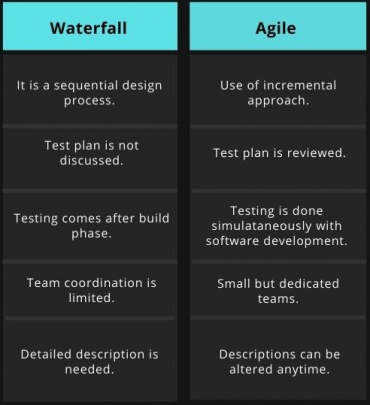Delivering to the customers efficiently has always been the top priority of every business.
In the technical world, it is only possible when the product is completed efficiently and well within time limits.
For such efficiency, organizations usually opt for two models, the Waterfall method and agile.
Waterfall methodology is also known as traditional approach methodology.
Agile methodology is often implemented using scrum technology.
Let us answer some questions related to the two methodologies.
Within waterfall methodology, the development team can only proceed to further testing if the earlier stages are completed successfully.
It is also known as Liner Sequential Life Cycle Model.
Within an agile methodology, a team-based approach is followed. Here, proper communication is promoted between customers, developers, managers, and testers.
Within this methodology, the development and the testing are done simultaneously.
Also Read: Understanding Pros and Cons of Agile Methodology
Some of the pros and cons of waterfall methodology are as below:
Pros
- Waterfall methodology is more detailed and is considered ideal for project planning.
- Every detail related to projects is clearly outlined. This develops a sense of trust among the clients.
- Delivery of the projects is much faster.
- Teams can easily adapt to this procedure.
- Each phase assures an efficient review process.
Cons
- Waterfall technology can’t be used for large size projects.
- Testing is done at the end of the project.
- Any change in the middle of the project is difficult to be addressed.
- Any change to be made at the previous stage cannot be done.
- Under unclear requirements this methodology proves ineffective.
Some of the pros and cons of Agile methodology are as below:
Pros
- Customers can bring out any change even after the initial stage and such changes can be easily addressed.
- The involvement of customers at every stage is entertained.
- Since each process is segregated into sprints, bugs can be easily resolved after the completion of a single sprint.
- Results can be examined easily at the end of each sprint.
- Rewritings are promoted under this methodology so as to achieve desired results.
Cons
- Since no schedule is available under this methodology, projects can be difficult to manage under tight schedules.
- A dedicated team is needed in this methodology and any absence of a team person can create issues in project execution.
- Though any change can be entertained in the middle of the project it can create problems for other organizations.
- Agile is not accepted for smaller projects.
- Experts' opinions if absent can create hurdles in the projects.
Some of the steps involved in Waterfall methodology are explained below:
Every requirement is analyzed within this step.
Moreover, all of these requirements are documented and a complete feasibility check is done to analyze whether such requirements can be accepted or not.
Both high-level designs, as well as low-level designs, are taken into considerations.
Within this step, all of the hardware and software requirements are evaluated.
This analysis includes languages, infrastructure, and much more.
This can be termed as the implementation part.
The system is designed into smaller parts known as units, and later on, every unit is then integrated after testing.
At this stage testing of the system is done.
Testers evaluate and analyze the program for any defects.
Client involvement is also done here to ensure every requirement is fulfilled.
After the testing part, support and maintenance are provided for the software to ensure that it runs smoothly without any further error.
Some of the steps involved in Agile methodology are as under:
Prioritizing the projects is done at this stage.
Majority of the time single teams work on multiple projects.
For every project, teams have to define the time requirement as well as the expertise the project will need.
Once a project work is finalized.
The team involved with the project has to present a flow chart to the client in order to make them understand how new feature should function.
Once the client sends its feedback, teams start working on the project.
The product developed under this project will have to be executed at the end of every sprint as agile methodology works in sprints.
This stage is where the proper support is provided in order to ensure that system is running smoothly.

Waterfall methodology is ideal in a situation where there has been a clear understanding of the final products.
The project or the code won’t be given to the client initially but only when the project is completed.
If a team is clear about the idea of a product and the client is also sure about the project's scope, then in such a situation, waterfall methodology can be easily adopted.
The agile methodology should only be adopted in situations where teams work on a timely basis. If the client expects the details of the project at certain stages, the agile methodology works better in such cases.
Moreover, there are other factors that need to be considered while selecting between the two methodologies. Some of such elements are Uncertainty levels, innovations, customer relations, etc.
Conclusion
Both of the methodologies assist organizations in the completion of the projects. However, what type of model should be adopted by an organization completely depends on the scope of the project, and its importance.
For smaller projects, waterfall technology could prove beneficial, whereas agile is better for other kinds of projects.
Also Read: Agile v/s Scrum? Things you need to know




